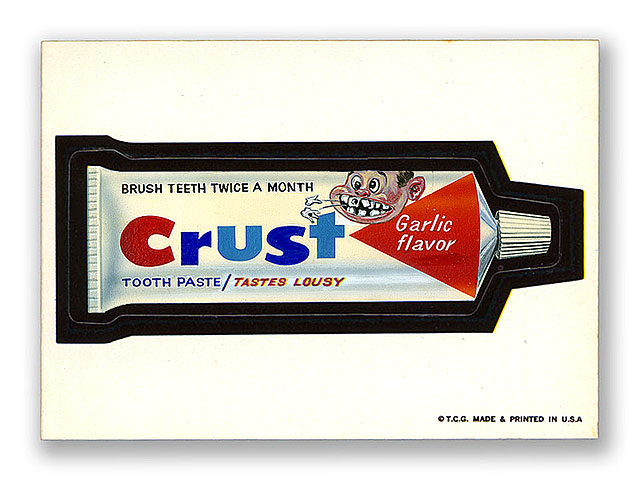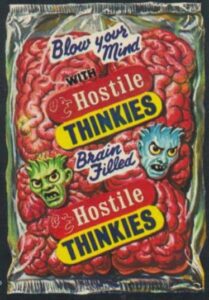
Two score and some odd years ago, when my second-grade friends and I tumbled out the doors of Missoula’s Lewis and Clark Elementary, Wacky Packages were for months on end our sole reason for a trip to the nearby Circle K convenience store.
Clutching our spare change so hard that the coins seemed to sweat in our palms, we plonked down twenty-five cents, seventy-five cents, and for those of us with parents of means, even whole dollars for these lurid “packs” filled with stickers brandishing satirical takes on mass-marketed brands and products.
Every pack in red-and-yellow wax wrapper featured a brittle stick of stale bubble gum dusted with teeth-rotting sugar. Those of us who went without lunch chewed the gum with relish, but the gum was beside the point. What mattered was honing our nascent humor on the broad, mischievous, and sometimes stomach-turning punchlines of these illustrated product parodies.
Hawaiian Punch became “Hawaiian Punks,” the “Bloody Nose Red” beverage that “Beats You to a Fruit Juicy Pulp” with a “Free Offer That You Can’t Refuse!” Ajax became “AJerx,” or “The Do-Nothing Cleanser: You Gotta Be a Jerk to Use It” and no longer endorsed but “Condemned by Good Housebreaking.” Liquid Plumber was dubbed “Liquid Bomber: Opens drains, doors, walls and innocent bystanders.” Minute Rice was the inedible, horrifying “Minute Lice: Makes 6 Sloppy Servings.”
You get the idea. My own favorite, among many, was “Crust” toothpaste. It dared to replace my mother’s household rule of brushing twice a day with “brush teeth twice a month.” Subversion was clearly part of these stickers’ enduring appeal. As you no doubt guessed, there is a thriving collectors’ market on eBay and throughout internet fandom, where adult fans still tend the flame. Today the meaning of “brand” has spread from products to people like a contagion to encompass personal and professional qualities and skills. Small wonder that we might still delight in mocking the term.
 According to those who kept track at the time, this product concocted by the Topps candy company raged so hard that between 1973 and 1975 Wacky Packages outsold even baseball cards. The humor they invoked was so childish and pun-reliant that it had at least a few miles to walk before it could even be called juvenile. But for those of us with at least three hours to kill before our single mothers got home to fix dinner, dealing these cards like poker hands was a liberating dose of belly laughs.
According to those who kept track at the time, this product concocted by the Topps candy company raged so hard that between 1973 and 1975 Wacky Packages outsold even baseball cards. The humor they invoked was so childish and pun-reliant that it had at least a few miles to walk before it could even be called juvenile. But for those of us with at least three hours to kill before our single mothers got home to fix dinner, dealing these cards like poker hands was a liberating dose of belly laughs.
Sometimes that liberating effect spread out into ill-fated attempts at small-time shoplifting, mixing chemicals into spare tires inside dilapidated garages to start small fires, or taking turns on the neighborhood bike to pop wheelies and jump over garbage pails of live frogs caught from the shallow ponds of big-winter snow-melts. The broken glass memories of a semi-rural latchkey kid settle into unstable kaleidoscopes. They are tainted by the random, reckless colors of wasted time, but shine brightly.
What makes Wacky Packages so remarkable now, aside from laughing at them even through the backward glance of adulthood, is to learn that they were created in part by the very Art Spiegelman who in 1992 was awarded the Pulitzer Prize for Maus, the now famous (and, shockingly, banned by one Tennessee school district) graphic novel recounting his father’s survival of the Holocaust.
Maus, too, is a vivid memory, albeit a very different one from the Wacky Packages of childhood. My mother, who years later married well enough to bring her struggling family into the middle class, gave me Spiegelman’s book as a Christmas present during my college years. Like every high school graduate with a casual knowledge of twentieth-century history, I learned about the Holocaust primarily via the graphic newsreels of the Allied victory over Nazi Germany. What was shocking beyond belief gained an immeasurable intimacy through Maus, in which Spiegelman’s disarmingly simple illustrations revealed how the trauma of surviving genocide outlives those who still manage to survive it. Along with Robert Crumb, Harvey Pekar, and Bill Griffith, creator of Zippy The Pinhead, Spiegelman would move on from his candy company job to become a founding force in underground comix that would, eventually, take the medium mainstream.
High culture routinely saves its most lavish praise for “master” painters and artists such as Michelangelo, Vasquez, Goya, or Hockney. It is the artistic forces behind the record-breaking bids at Christie’s and other auction houses that make the news. They have their glory, and billionaire collectors have the power to horde or share that glory. No one who loves art and great paintings is going to naysay their legacy. Spiegelman, though, is that rare artist who knows that great art can also disregard the precision brush strokes of attempting “the masterpiece.” The ability to make school children laugh with abandon, then turn around to render a true-life account of the deepest suffering and trauma, is to play a field so wide and versatile that even a Michelangelo, Vasquez, Goya, or Hockney would never be up for such a challenge. Versatility, scope, and range are themselves the material, even the “stuff,” of true art. If art truly matters, it should matter throughout our short lives.
